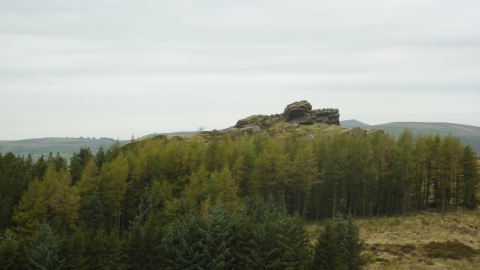Know before you go
Dogs
Please keep dogs close to you, preferably on a lead, especially between April and July when many birds are nesting on or close to the ground.
When to visit
Opening times
Open at all timesBest time to visit
Throughout the yearAbout the reserve
Highlights
- Listen out for the sound of migratory curlews returning to the moorlands and heralding the start of spring
- Walk to the hill at Gib Torr rocks and take in the wonderful views across this special moorland landscape
Moorland restoration and broadleaf woodland creation
There is an exciting future ahead for Black Brook nature reserve. Staffordshire Wildlife Trust is transforming the landscape, restoring a conifer plantation to dramatic open moorland mixed with peaceful native woodland. Click here to find out more about this long-term conservation project, or read on to discover more about the wildlife of Black Brook.
Magical moorland
At over 300 acres, Black Brook is one of Staffordshire Wildlife Trust’s largest nature reserves, with the neighbouring Roaches Estate being the largest. Around two thirds of Black Brook nature reserve is moorland, which is an extremely precious and rare wildlife habitat. On a global scale, moorland is rarer than rainforest, and because of its scarcity, the land has been protected for nature conservation purposes. The moorland is part of the Leek Moors Site of Special Scientific Interest (SSSI), and most of the reserve is also within a Special Conservation Area (SAC) and Special Protection Area (SPA).
Haven for rare birds
Many of the UK’s endangered upland birds require large open spaces to survive, and this part of the Leek Moors is becoming a hotspot for them. Listen out for the distinctive bubbling call of the curlew echoing across the moors in late spring, or try and spot a short-eared owl as it quarters low across the open moorland where it nests. If you’re really lucky and explore the reserve early in the morning, you may also catch a glimpse of a red grouse. These rich, russet-red birds feed on heather and will suddenly fly upwards with rapid, whirring wing-beats if disturbed.
On the ground
Around your feet, if you look closely you’ll find a host of rare moorland plants. Amongst the heather, which transforms the reserve into a sea of purple in late summer, you’ll discover patches of bilberry, crowberry and cowberry and drifts of delicate cotton grass. These plants in turn support specialist moorland species like the rare moorland bumblebee, beautiful green hairstreak butterfly and moths such as glaucous shears and light knotgrass.
Conservation work at Black Brook
In the 1970s, a commercial forestry company planted a large conifer plantation on top of the moorland at Black Brook, which now covers a third of the reserve. These non-native trees were never harvested, and sadly their value to wildlife is limited. When Staffordshire Wildlife Trust bought the reserve in 1996, its long-term vision was to remove the plantation and restore the landscape so it was more beneficial to wildlife.
A Living Landscape
'Living Landscapes' is The Wildlife Trusts innovative approach to nature conservation and involves focusing our efforts on improving the wider landscape to make it better for wildlife. Find out more here







